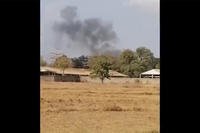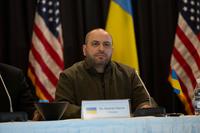WASHINGTON — The United States has quietly delivered the long-range ballistic missiles that Ukraine said it urgently needed and that President Joe Biden promised last month, Ukrainian President Volodymyr Zelenskyy confirmed Tuesday, saying they were used on the battlefield against Russia and “executed very accurately.”
”Today I express special gratitude to the United States," Zelenskyy said in his evening address, adding that the missiles “have proven themselves.”
The U.S. has refused to discuss the delivery publicly, but officials familiar with the move also confirmed it earlier in the day. The missiles got into Ukraine within the last few days, said one of the U.S. officials. Their arrival at the warfront gives Ukraine a critical ability to strike Russian targets that are farther away, allowing Ukrainian forces to stay safely out of range. The officials were not authorized to publicly discuss the matter before an official announcement and spoke Tuesday on the condition of anonymity.
The delivery of the Army Tactical Missile System, known as ATACMS, was shrouded in secrecy, with the expectation that the first public acknowledgment would come when the missiles were used on the battlefield. That intense secrecy is a marked change from previous U.S. weapons sent by the Biden administration. In nearly all other cases, the U.S. has publicly announced its decision prior to the weapons and equipment being shipped overseas.
Because of lingering U.S. concerns about escalating tensions with Russia, the ATACMS version that went to Ukraine will have a shorter range than the maximum distance the missiles can have. While some versions of the missiles can go as far as about 180 miles (300 kilometers), the ones sent to Ukraine have a shorter range and carry cluster munitions, which, when fired, open in the air, releasing hundreds of bomblets rather than a single warhead.
Ukraine’s Special Operations Forces claimed that a nighttime attack on targets in eastern and southern Ukraine destroyed nine Russian helicopters and other military equipment and personnel at two airfields in Russia-occupied regions.
The ATACMS would be key in Ukraine’s ability to hit the airfield in Berdyansk since it is within striking distance of the shorter-range version of the missile, and the cluster munitions would be effective in hitting multiple targets. The closest Ukrainian troop positions on the western bank of the Dnieper River are just about 100 miles (160 kilometers) from Berdyansk.
Zelenskyy and other Ukrainian leaders had been pressing the U.S. to provide the missiles, which have a longer range than any others provided by the U.S. But the Biden administration balked for months, worried that Kyiv could use the weapons to hit deep into Russian territory, enraging Moscow and escalating the conflict.
Biden finally greenlighted the delivery last month and told Zelenskyy during a meeting at the White House that the U.S. would finally give Ukraine the ATACMS, according to officials at the time. The U.S., however, has refused to provide any details on timing or how many missiles would be delivered, although officials suggested that the plan was to send a small number, roughly two dozen.
Ukrainian forces want to use the missiles to help fuel their counteroffensive as it heads into the muddy and colder winter months, enabling troops to strike behind Russian lines while staying out of firing range.
The small number of missiles underscores the U.S. reluctance to send the powerful weapons. Sending the cluster munition version will mark the second time the Democratic administration has moved to send that type of weapon.
In July, the U.S. agreed to send thousands of cluster bombs to Ukraine. When used, the bomblets are dispersed over a large area and are intended to wreak destruction on multiple targets at once. The weapons are banned by many NATO allies because they have a track record for causing many civilian casualties. Unexploded rounds, which often litter battlefields and populated civilian areas, can cause unintended deaths.
____
Associated Press writers Hanna Arhirova and Illia Novikov in Kyiv contributed to this report.












